Physical fitness, wellness, or health plays a pivotal role in a person’s life.
VerifiedAdded on 2022/05/23
|9
|2441
|8
AI Summary
Contribute Materials
Your contribution can guide someone’s learning journey. Share your
documents today.

Running head: PHYSICAL FITNESS 1
Importance of Physical Fitness
Student’s Name
University Affiliate
Importance of Physical Fitness
Student’s Name
University Affiliate
Secure Best Marks with AI Grader
Need help grading? Try our AI Grader for instant feedback on your assignments.
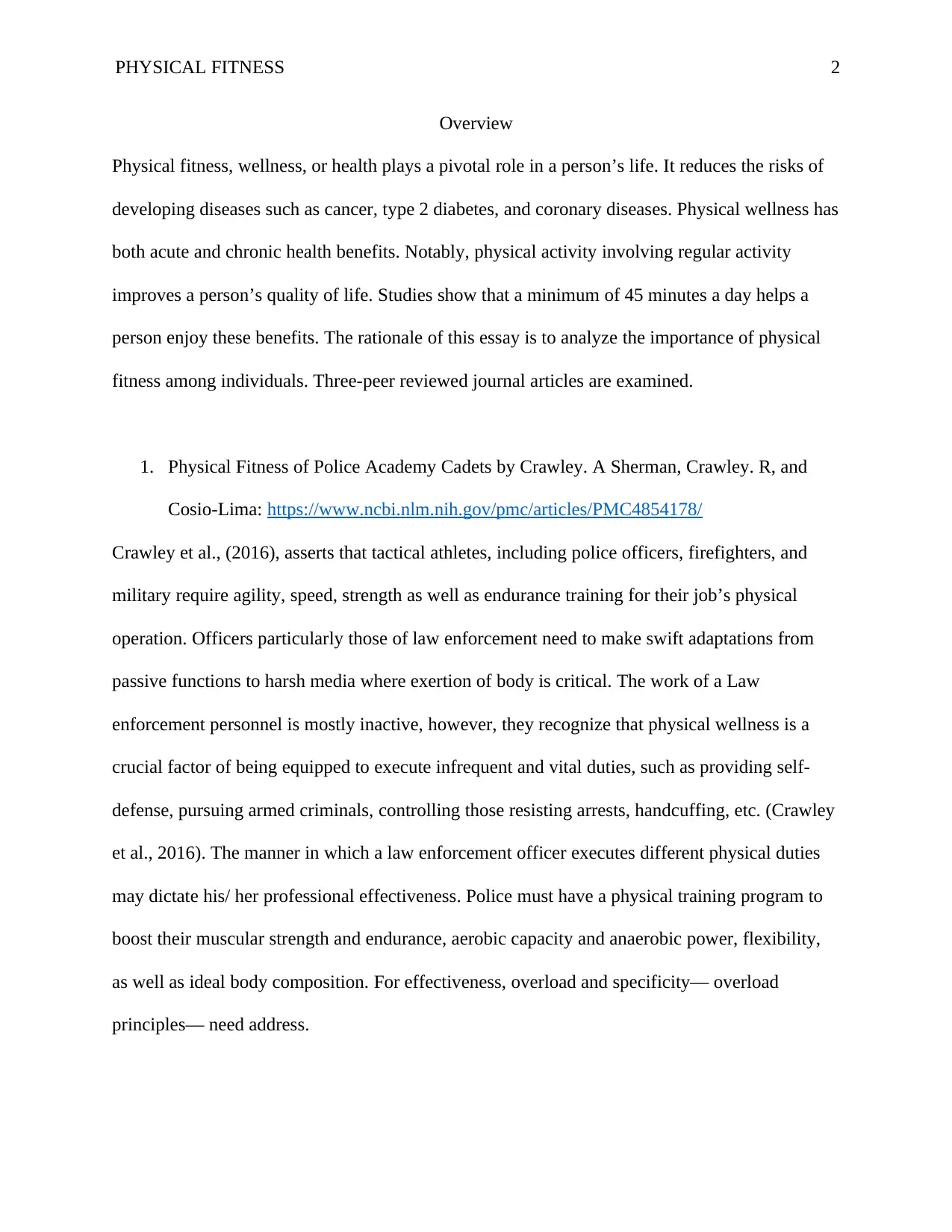
PHYSICAL FITNESS 2
Overview
Physical fitness, wellness, or health plays a pivotal role in a person’s life. It reduces the risks of
developing diseases such as cancer, type 2 diabetes, and coronary diseases. Physical wellness has
both acute and chronic health benefits. Notably, physical activity involving regular activity
improves a person’s quality of life. Studies show that a minimum of 45 minutes a day helps a
person enjoy these benefits. The rationale of this essay is to analyze the importance of physical
fitness among individuals. Three-peer reviewed journal articles are examined.
1. Physical Fitness of Police Academy Cadets by Crawley. A Sherman, Crawley. R, and
Cosio-Lima: https://www.ncbi.nlm.nih.gov/pmc/articles/PMC4854178/
Crawley et al., (2016), asserts that tactical athletes, including police officers, firefighters, and
military require agility, speed, strength as well as endurance training for their job’s physical
operation. Officers particularly those of law enforcement need to make swift adaptations from
passive functions to harsh media where exertion of body is critical. The work of a Law
enforcement personnel is mostly inactive, however, they recognize that physical wellness is a
crucial factor of being equipped to execute infrequent and vital duties, such as providing self-
defense, pursuing armed criminals, controlling those resisting arrests, handcuffing, etc. (Crawley
et al., 2016). The manner in which a law enforcement officer executes different physical duties
may dictate his/ her professional effectiveness. Police must have a physical training program to
boost their muscular strength and endurance, aerobic capacity and anaerobic power, flexibility,
as well as ideal body composition. For effectiveness, overload and specificity— overload
principles— need address.
Overview
Physical fitness, wellness, or health plays a pivotal role in a person’s life. It reduces the risks of
developing diseases such as cancer, type 2 diabetes, and coronary diseases. Physical wellness has
both acute and chronic health benefits. Notably, physical activity involving regular activity
improves a person’s quality of life. Studies show that a minimum of 45 minutes a day helps a
person enjoy these benefits. The rationale of this essay is to analyze the importance of physical
fitness among individuals. Three-peer reviewed journal articles are examined.
1. Physical Fitness of Police Academy Cadets by Crawley. A Sherman, Crawley. R, and
Cosio-Lima: https://www.ncbi.nlm.nih.gov/pmc/articles/PMC4854178/
Crawley et al., (2016), asserts that tactical athletes, including police officers, firefighters, and
military require agility, speed, strength as well as endurance training for their job’s physical
operation. Officers particularly those of law enforcement need to make swift adaptations from
passive functions to harsh media where exertion of body is critical. The work of a Law
enforcement personnel is mostly inactive, however, they recognize that physical wellness is a
crucial factor of being equipped to execute infrequent and vital duties, such as providing self-
defense, pursuing armed criminals, controlling those resisting arrests, handcuffing, etc. (Crawley
et al., 2016). The manner in which a law enforcement officer executes different physical duties
may dictate his/ her professional effectiveness. Police must have a physical training program to
boost their muscular strength and endurance, aerobic capacity and anaerobic power, flexibility,
as well as ideal body composition. For effectiveness, overload and specificity— overload
principles— need address.

PHYSICAL FITNESS 3
According to Crawley et al., (2016), 68 cadet officers were subjected to research first to establish
baseline pre-academy physical wellness data of the officers and to investigate how a supervised
16-week physical wellness program would affect the academy cadets. Some of the procedures
the officers did include physical fitness training done at the first, eight, and week sixteen of the
officer's academy. In skinfold’s sum, measurements were from officers wearing shorts and a
sports top. Other procures were handgrip strength test, agility-T test, sprint speed, sit and reach
flexibility, upper as well as lower-body power tests, etc. The article concludes that all law
enforcement personnel must perform highly physical as well as engaging mental plans including
reacting to stress instinctively, making right decisions in critical moments and shooting under
duress (Crawley et al., 2016). Besides, appropriate physical training should produce a person that
can successfully operate in a stressful environment and have proper physical wellness or fitness
to well in such media.
2. Cardiovascular Role Of Group Sports Interventions: The Need For Improved Fitness In
Risk Reduction by Jari Laukkanen:
https://www.mayoclinicproceedings.org/article/S0025-6196(18)30669-4/abstract
Laukkanen in his article Cardiovascular Benefits of Group Sports Interventions, implementation
of sports groups can prevent coronary diseases events. Both soccer and running can also improve
cardiorespiratory fitness as well as coronary function. The author also demonstrates that previous
researches have endorsed aerobic training as a way to boost lipid profile as well as lower blood
pressure and body mass index. Moreover, he acknowledges that high-intensity interval training is
a way to promote fitness plus coronary risk factor profile. As per Laukkanen (2018), current
evidence indicates that high-intensity training may boost maximum oxygen uptake as well as
raise cardiometabolic risk factors such as lipids levels and blood pressure. Physical wellness
According to Crawley et al., (2016), 68 cadet officers were subjected to research first to establish
baseline pre-academy physical wellness data of the officers and to investigate how a supervised
16-week physical wellness program would affect the academy cadets. Some of the procedures
the officers did include physical fitness training done at the first, eight, and week sixteen of the
officer's academy. In skinfold’s sum, measurements were from officers wearing shorts and a
sports top. Other procures were handgrip strength test, agility-T test, sprint speed, sit and reach
flexibility, upper as well as lower-body power tests, etc. The article concludes that all law
enforcement personnel must perform highly physical as well as engaging mental plans including
reacting to stress instinctively, making right decisions in critical moments and shooting under
duress (Crawley et al., 2016). Besides, appropriate physical training should produce a person that
can successfully operate in a stressful environment and have proper physical wellness or fitness
to well in such media.
2. Cardiovascular Role Of Group Sports Interventions: The Need For Improved Fitness In
Risk Reduction by Jari Laukkanen:
https://www.mayoclinicproceedings.org/article/S0025-6196(18)30669-4/abstract
Laukkanen in his article Cardiovascular Benefits of Group Sports Interventions, implementation
of sports groups can prevent coronary diseases events. Both soccer and running can also improve
cardiorespiratory fitness as well as coronary function. The author also demonstrates that previous
researches have endorsed aerobic training as a way to boost lipid profile as well as lower blood
pressure and body mass index. Moreover, he acknowledges that high-intensity interval training is
a way to promote fitness plus coronary risk factor profile. As per Laukkanen (2018), current
evidence indicates that high-intensity training may boost maximum oxygen uptake as well as
raise cardiometabolic risk factors such as lipids levels and blood pressure. Physical wellness
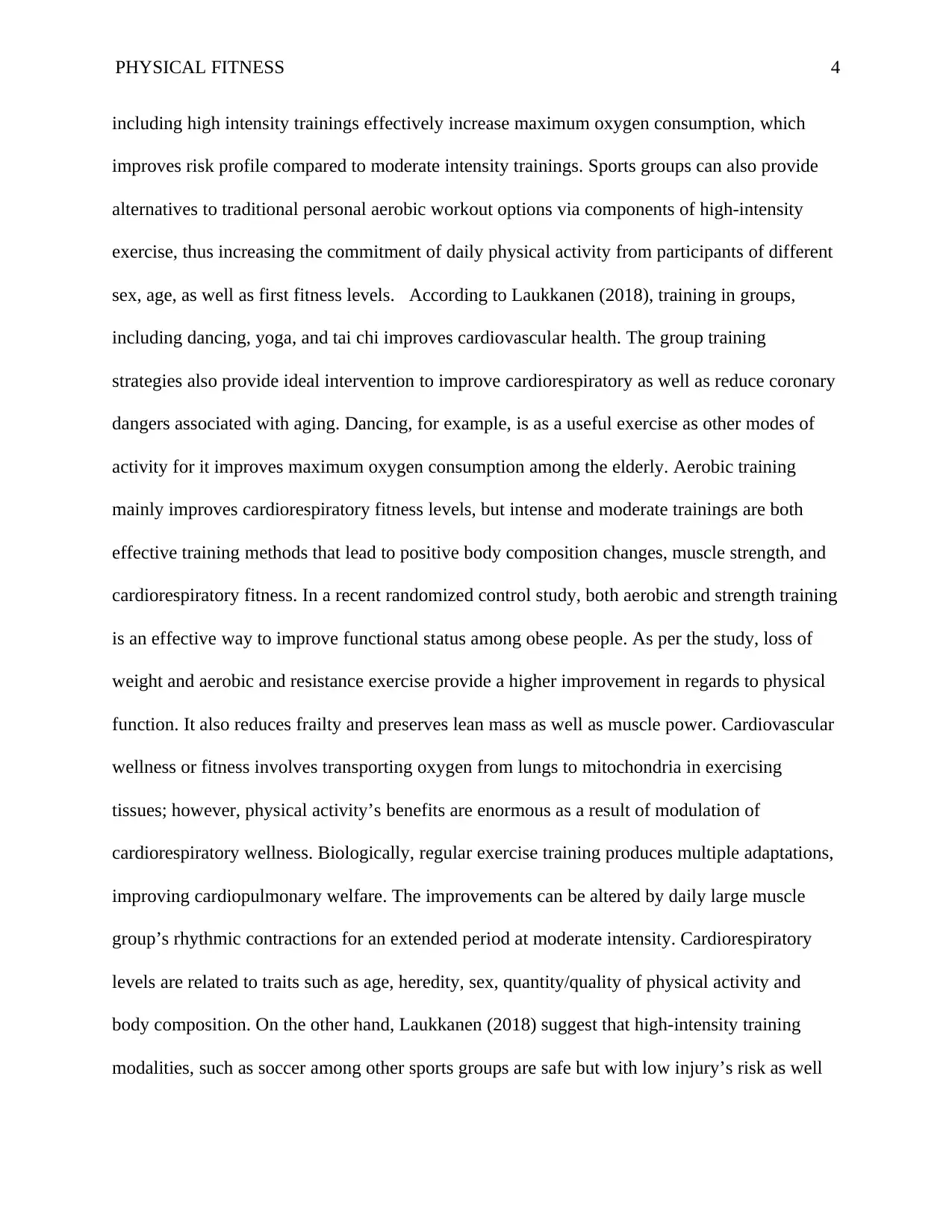
PHYSICAL FITNESS 4
including high intensity trainings effectively increase maximum oxygen consumption, which
improves risk profile compared to moderate intensity trainings. Sports groups can also provide
alternatives to traditional personal aerobic workout options via components of high-intensity
exercise, thus increasing the commitment of daily physical activity from participants of different
sex, age, as well as first fitness levels. According to Laukkanen (2018), training in groups,
including dancing, yoga, and tai chi improves cardiovascular health. The group training
strategies also provide ideal intervention to improve cardiorespiratory as well as reduce coronary
dangers associated with aging. Dancing, for example, is as a useful exercise as other modes of
activity for it improves maximum oxygen consumption among the elderly. Aerobic training
mainly improves cardiorespiratory fitness levels, but intense and moderate trainings are both
effective training methods that lead to positive body composition changes, muscle strength, and
cardiorespiratory fitness. In a recent randomized control study, both aerobic and strength training
is an effective way to improve functional status among obese people. As per the study, loss of
weight and aerobic and resistance exercise provide a higher improvement in regards to physical
function. It also reduces frailty and preserves lean mass as well as muscle power. Cardiovascular
wellness or fitness involves transporting oxygen from lungs to mitochondria in exercising
tissues; however, physical activity’s benefits are enormous as a result of modulation of
cardiorespiratory wellness. Biologically, regular exercise training produces multiple adaptations,
improving cardiopulmonary welfare. The improvements can be altered by daily large muscle
group’s rhythmic contractions for an extended period at moderate intensity. Cardiorespiratory
levels are related to traits such as age, heredity, sex, quantity/quality of physical activity and
body composition. On the other hand, Laukkanen (2018) suggest that high-intensity training
modalities, such as soccer among other sports groups are safe but with low injury’s risk as well
including high intensity trainings effectively increase maximum oxygen consumption, which
improves risk profile compared to moderate intensity trainings. Sports groups can also provide
alternatives to traditional personal aerobic workout options via components of high-intensity
exercise, thus increasing the commitment of daily physical activity from participants of different
sex, age, as well as first fitness levels. According to Laukkanen (2018), training in groups,
including dancing, yoga, and tai chi improves cardiovascular health. The group training
strategies also provide ideal intervention to improve cardiorespiratory as well as reduce coronary
dangers associated with aging. Dancing, for example, is as a useful exercise as other modes of
activity for it improves maximum oxygen consumption among the elderly. Aerobic training
mainly improves cardiorespiratory fitness levels, but intense and moderate trainings are both
effective training methods that lead to positive body composition changes, muscle strength, and
cardiorespiratory fitness. In a recent randomized control study, both aerobic and strength training
is an effective way to improve functional status among obese people. As per the study, loss of
weight and aerobic and resistance exercise provide a higher improvement in regards to physical
function. It also reduces frailty and preserves lean mass as well as muscle power. Cardiovascular
wellness or fitness involves transporting oxygen from lungs to mitochondria in exercising
tissues; however, physical activity’s benefits are enormous as a result of modulation of
cardiorespiratory wellness. Biologically, regular exercise training produces multiple adaptations,
improving cardiopulmonary welfare. The improvements can be altered by daily large muscle
group’s rhythmic contractions for an extended period at moderate intensity. Cardiorespiratory
levels are related to traits such as age, heredity, sex, quantity/quality of physical activity and
body composition. On the other hand, Laukkanen (2018) suggest that high-intensity training
modalities, such as soccer among other sports groups are safe but with low injury’s risk as well
Paraphrase This Document
Need a fresh take? Get an instant paraphrase of this document with our AI Paraphraser

PHYSICAL FITNESS 5
as engaging interventions for cardiometabolic risk reduction even amongst hypersensitive and
diabetic individuals.
In conclusion, the author states that it is ideal to keep good cardiorespiratory fitness levels over
an extended period to boost health outcomes. A different prospective study shows that smaller
shift or decline in maximum oxygen consumption over a decade can lower risks of death. In his
closing remarks, the author proposes a high-quality research work be done to determine whether
decreased coronary diseases, as well as all-cause death rate, may be attained via incorporating
habitual recreational sports as a patient lifestyle’s component.
3. Role of Physical Activity and Fitness in the Promotion of Metabolic and Overall Health
by Francisco B Ortega, Enrique G, David Jimenez-Pavon, and Jonathan R:
http://eurjhm.com/index.php/eurjhm/article/view/474/635
Ortega et al., (2018), asserts that physical wellness is an excellent marker of health among the
youth and adults, as well as, the cardiorespiratory fitness and of muscles, are highly related to
health. Cardiorespiratory fitness and physical activity have positive effects on obesity, insulin
resistance, cardiometabolic profile, leptin levels, as well as other metabolic conditions. Both
children and adolescents should regularly undertake a 60 minute moderate to vigorous physical
activity (Ortega et al., 2018). However, a 20 minute of strenuous exercise can lower the
cardiometabolic risk score. Cardiorespiratory fitness and physical wellness both boost cognitive
function. They mediate adipocytokines as well as myokines influence on cognition, promoting a
healthier brain. Other suggestions have indicated that specific molecular mechanism connects
aerobic exercise plus cardiorespiratory fitness with the entire health, not forgetting metabolic
disorders as well as brain health conditions. Notably, fibronectin, a type 3 domain, directly
influences brain-derived neurotrophic factor level, thus affecting cognitive function. Muscular
as engaging interventions for cardiometabolic risk reduction even amongst hypersensitive and
diabetic individuals.
In conclusion, the author states that it is ideal to keep good cardiorespiratory fitness levels over
an extended period to boost health outcomes. A different prospective study shows that smaller
shift or decline in maximum oxygen consumption over a decade can lower risks of death. In his
closing remarks, the author proposes a high-quality research work be done to determine whether
decreased coronary diseases, as well as all-cause death rate, may be attained via incorporating
habitual recreational sports as a patient lifestyle’s component.
3. Role of Physical Activity and Fitness in the Promotion of Metabolic and Overall Health
by Francisco B Ortega, Enrique G, David Jimenez-Pavon, and Jonathan R:
http://eurjhm.com/index.php/eurjhm/article/view/474/635
Ortega et al., (2018), asserts that physical wellness is an excellent marker of health among the
youth and adults, as well as, the cardiorespiratory fitness and of muscles, are highly related to
health. Cardiorespiratory fitness and physical activity have positive effects on obesity, insulin
resistance, cardiometabolic profile, leptin levels, as well as other metabolic conditions. Both
children and adolescents should regularly undertake a 60 minute moderate to vigorous physical
activity (Ortega et al., 2018). However, a 20 minute of strenuous exercise can lower the
cardiometabolic risk score. Cardiorespiratory fitness and physical wellness both boost cognitive
function. They mediate adipocytokines as well as myokines influence on cognition, promoting a
healthier brain. Other suggestions have indicated that specific molecular mechanism connects
aerobic exercise plus cardiorespiratory fitness with the entire health, not forgetting metabolic
disorders as well as brain health conditions. Notably, fibronectin, a type 3 domain, directly
influences brain-derived neurotrophic factor level, thus affecting cognitive function. Muscular
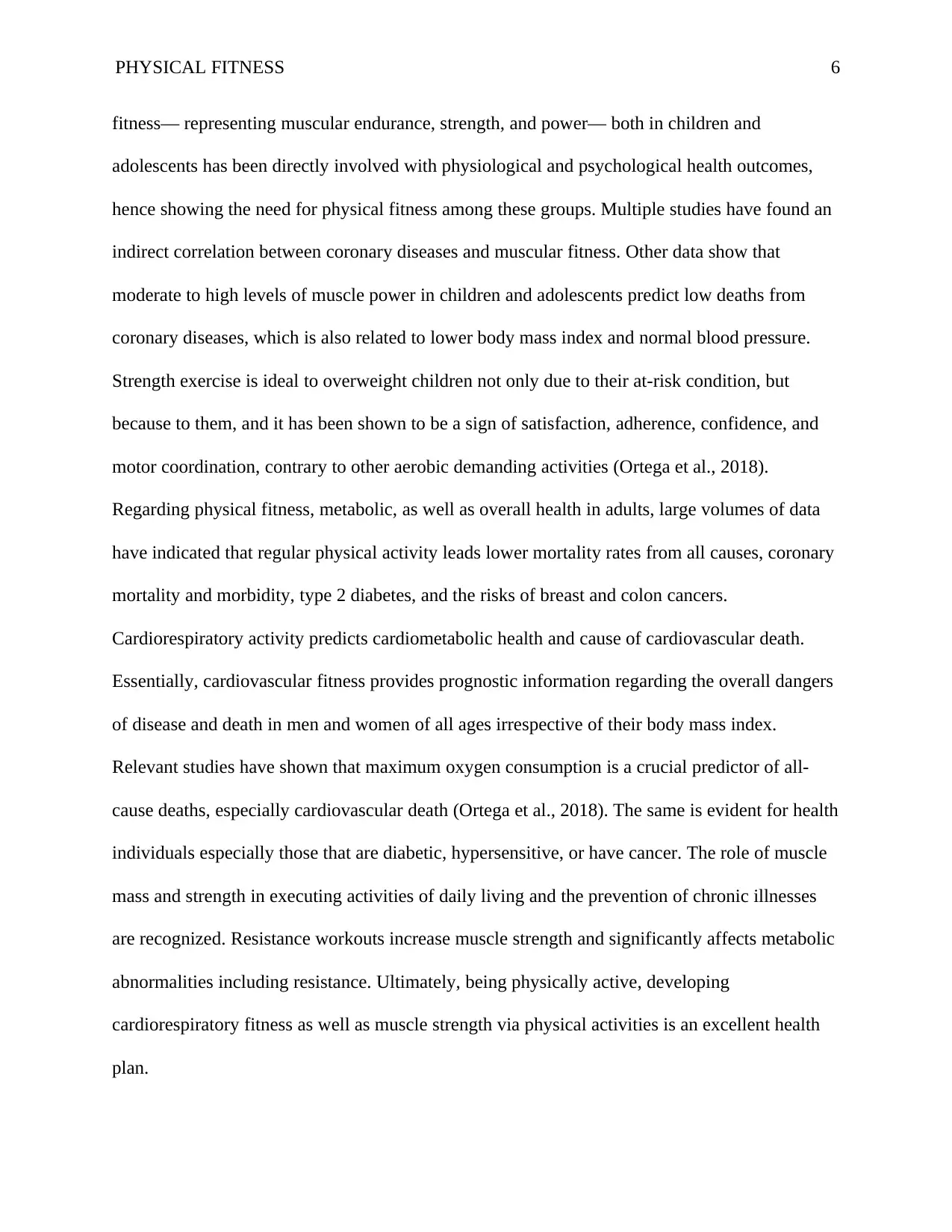
PHYSICAL FITNESS 6
fitness— representing muscular endurance, strength, and power— both in children and
adolescents has been directly involved with physiological and psychological health outcomes,
hence showing the need for physical fitness among these groups. Multiple studies have found an
indirect correlation between coronary diseases and muscular fitness. Other data show that
moderate to high levels of muscle power in children and adolescents predict low deaths from
coronary diseases, which is also related to lower body mass index and normal blood pressure.
Strength exercise is ideal to overweight children not only due to their at-risk condition, but
because to them, and it has been shown to be a sign of satisfaction, adherence, confidence, and
motor coordination, contrary to other aerobic demanding activities (Ortega et al., 2018).
Regarding physical fitness, metabolic, as well as overall health in adults, large volumes of data
have indicated that regular physical activity leads lower mortality rates from all causes, coronary
mortality and morbidity, type 2 diabetes, and the risks of breast and colon cancers.
Cardiorespiratory activity predicts cardiometabolic health and cause of cardiovascular death.
Essentially, cardiovascular fitness provides prognostic information regarding the overall dangers
of disease and death in men and women of all ages irrespective of their body mass index.
Relevant studies have shown that maximum oxygen consumption is a crucial predictor of all-
cause deaths, especially cardiovascular death (Ortega et al., 2018). The same is evident for health
individuals especially those that are diabetic, hypersensitive, or have cancer. The role of muscle
mass and strength in executing activities of daily living and the prevention of chronic illnesses
are recognized. Resistance workouts increase muscle strength and significantly affects metabolic
abnormalities including resistance. Ultimately, being physically active, developing
cardiorespiratory fitness as well as muscle strength via physical activities is an excellent health
plan.
fitness— representing muscular endurance, strength, and power— both in children and
adolescents has been directly involved with physiological and psychological health outcomes,
hence showing the need for physical fitness among these groups. Multiple studies have found an
indirect correlation between coronary diseases and muscular fitness. Other data show that
moderate to high levels of muscle power in children and adolescents predict low deaths from
coronary diseases, which is also related to lower body mass index and normal blood pressure.
Strength exercise is ideal to overweight children not only due to their at-risk condition, but
because to them, and it has been shown to be a sign of satisfaction, adherence, confidence, and
motor coordination, contrary to other aerobic demanding activities (Ortega et al., 2018).
Regarding physical fitness, metabolic, as well as overall health in adults, large volumes of data
have indicated that regular physical activity leads lower mortality rates from all causes, coronary
mortality and morbidity, type 2 diabetes, and the risks of breast and colon cancers.
Cardiorespiratory activity predicts cardiometabolic health and cause of cardiovascular death.
Essentially, cardiovascular fitness provides prognostic information regarding the overall dangers
of disease and death in men and women of all ages irrespective of their body mass index.
Relevant studies have shown that maximum oxygen consumption is a crucial predictor of all-
cause deaths, especially cardiovascular death (Ortega et al., 2018). The same is evident for health
individuals especially those that are diabetic, hypersensitive, or have cancer. The role of muscle
mass and strength in executing activities of daily living and the prevention of chronic illnesses
are recognized. Resistance workouts increase muscle strength and significantly affects metabolic
abnormalities including resistance. Ultimately, being physically active, developing
cardiorespiratory fitness as well as muscle strength via physical activities is an excellent health
plan.
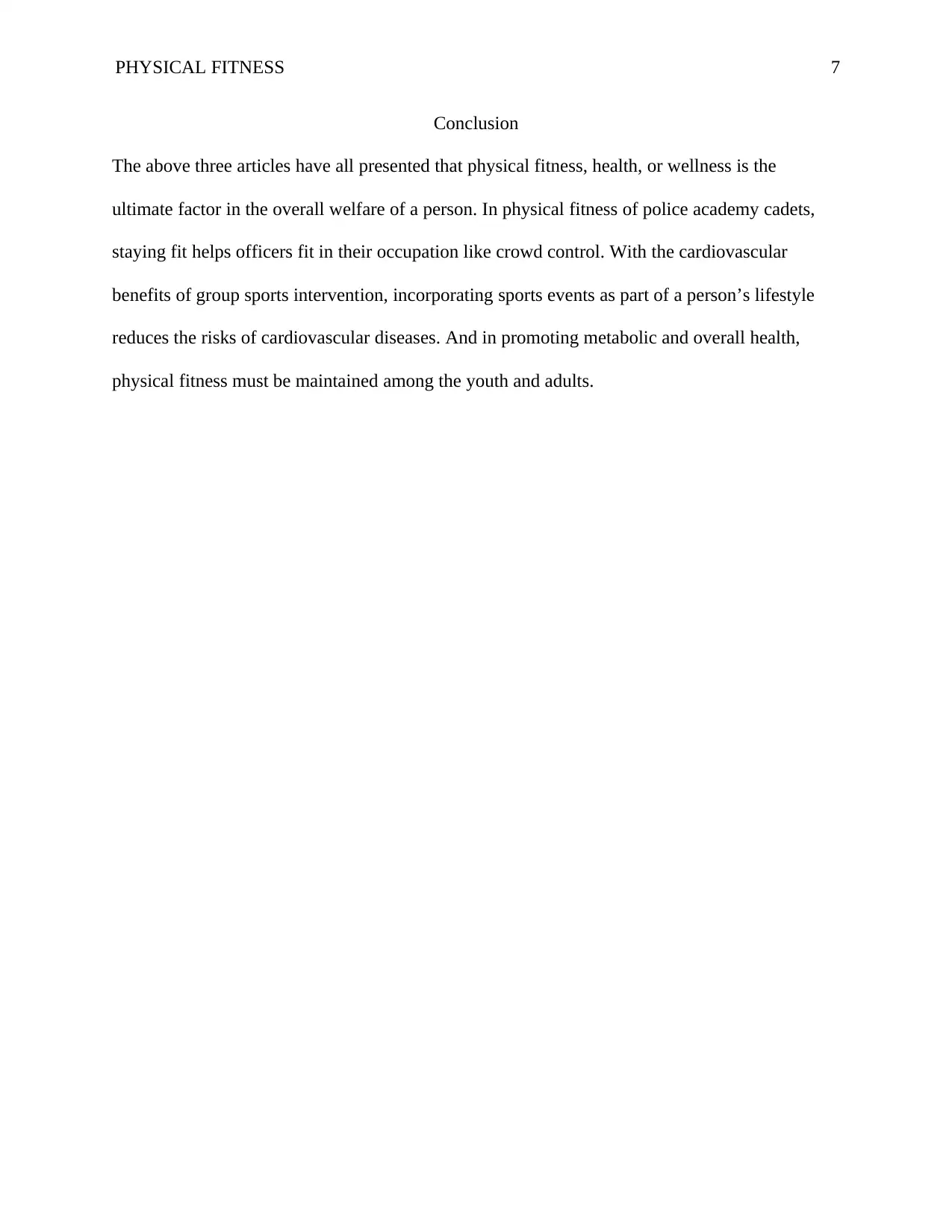
PHYSICAL FITNESS 7
Conclusion
The above three articles have all presented that physical fitness, health, or wellness is the
ultimate factor in the overall welfare of a person. In physical fitness of police academy cadets,
staying fit helps officers fit in their occupation like crowd control. With the cardiovascular
benefits of group sports intervention, incorporating sports events as part of a person’s lifestyle
reduces the risks of cardiovascular diseases. And in promoting metabolic and overall health,
physical fitness must be maintained among the youth and adults.
Conclusion
The above three articles have all presented that physical fitness, health, or wellness is the
ultimate factor in the overall welfare of a person. In physical fitness of police academy cadets,
staying fit helps officers fit in their occupation like crowd control. With the cardiovascular
benefits of group sports intervention, incorporating sports events as part of a person’s lifestyle
reduces the risks of cardiovascular diseases. And in promoting metabolic and overall health,
physical fitness must be maintained among the youth and adults.
Secure Best Marks with AI Grader
Need help grading? Try our AI Grader for instant feedback on your assignments.
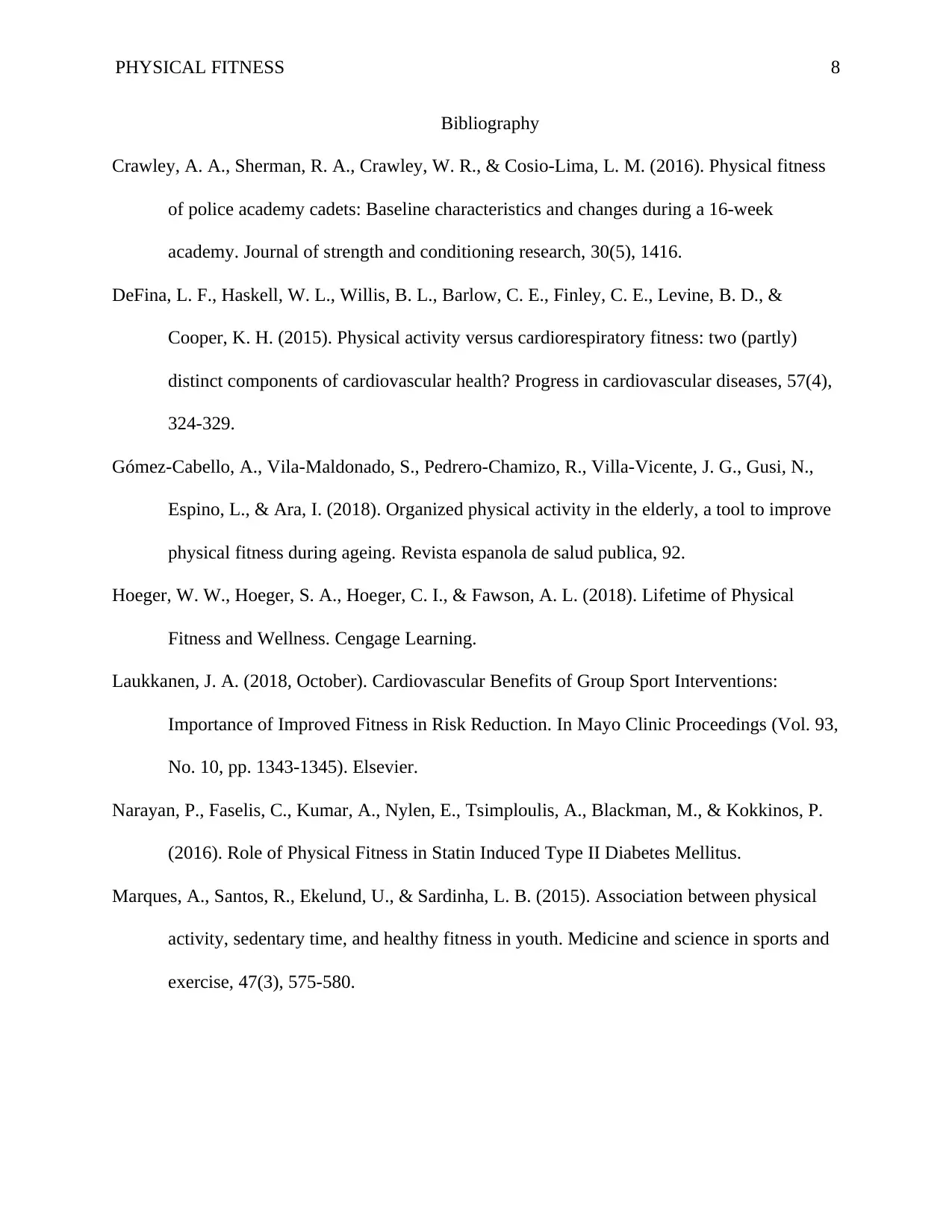
PHYSICAL FITNESS 8
Bibliography
Crawley, A. A., Sherman, R. A., Crawley, W. R., & Cosio-Lima, L. M. (2016). Physical fitness
of police academy cadets: Baseline characteristics and changes during a 16-week
academy. Journal of strength and conditioning research, 30(5), 1416.
DeFina, L. F., Haskell, W. L., Willis, B. L., Barlow, C. E., Finley, C. E., Levine, B. D., &
Cooper, K. H. (2015). Physical activity versus cardiorespiratory fitness: two (partly)
distinct components of cardiovascular health? Progress in cardiovascular diseases, 57(4),
324-329.
Gómez-Cabello, A., Vila-Maldonado, S., Pedrero-Chamizo, R., Villa-Vicente, J. G., Gusi, N.,
Espino, L., & Ara, I. (2018). Organized physical activity in the elderly, a tool to improve
physical fitness during ageing. Revista espanola de salud publica, 92.
Hoeger, W. W., Hoeger, S. A., Hoeger, C. I., & Fawson, A. L. (2018). Lifetime of Physical
Fitness and Wellness. Cengage Learning.
Laukkanen, J. A. (2018, October). Cardiovascular Benefits of Group Sport Interventions:
Importance of Improved Fitness in Risk Reduction. In Mayo Clinic Proceedings (Vol. 93,
No. 10, pp. 1343-1345). Elsevier.
Narayan, P., Faselis, C., Kumar, A., Nylen, E., Tsimploulis, A., Blackman, M., & Kokkinos, P.
(2016). Role of Physical Fitness in Statin Induced Type II Diabetes Mellitus.
Marques, A., Santos, R., Ekelund, U., & Sardinha, L. B. (2015). Association between physical
activity, sedentary time, and healthy fitness in youth. Medicine and science in sports and
exercise, 47(3), 575-580.
Bibliography
Crawley, A. A., Sherman, R. A., Crawley, W. R., & Cosio-Lima, L. M. (2016). Physical fitness
of police academy cadets: Baseline characteristics and changes during a 16-week
academy. Journal of strength and conditioning research, 30(5), 1416.
DeFina, L. F., Haskell, W. L., Willis, B. L., Barlow, C. E., Finley, C. E., Levine, B. D., &
Cooper, K. H. (2015). Physical activity versus cardiorespiratory fitness: two (partly)
distinct components of cardiovascular health? Progress in cardiovascular diseases, 57(4),
324-329.
Gómez-Cabello, A., Vila-Maldonado, S., Pedrero-Chamizo, R., Villa-Vicente, J. G., Gusi, N.,
Espino, L., & Ara, I. (2018). Organized physical activity in the elderly, a tool to improve
physical fitness during ageing. Revista espanola de salud publica, 92.
Hoeger, W. W., Hoeger, S. A., Hoeger, C. I., & Fawson, A. L. (2018). Lifetime of Physical
Fitness and Wellness. Cengage Learning.
Laukkanen, J. A. (2018, October). Cardiovascular Benefits of Group Sport Interventions:
Importance of Improved Fitness in Risk Reduction. In Mayo Clinic Proceedings (Vol. 93,
No. 10, pp. 1343-1345). Elsevier.
Narayan, P., Faselis, C., Kumar, A., Nylen, E., Tsimploulis, A., Blackman, M., & Kokkinos, P.
(2016). Role of Physical Fitness in Statin Induced Type II Diabetes Mellitus.
Marques, A., Santos, R., Ekelund, U., & Sardinha, L. B. (2015). Association between physical
activity, sedentary time, and healthy fitness in youth. Medicine and science in sports and
exercise, 47(3), 575-580.
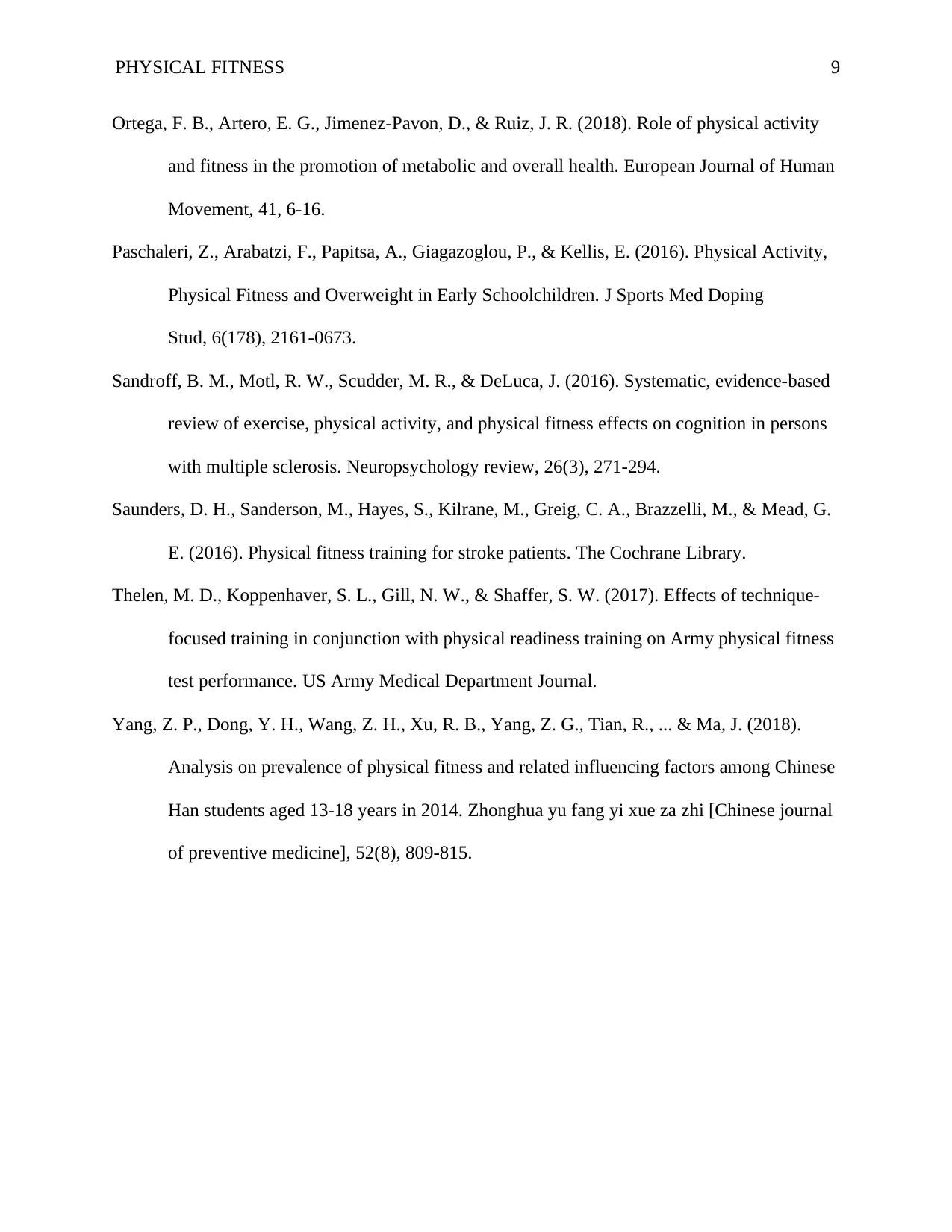
PHYSICAL FITNESS 9
Ortega, F. B., Artero, E. G., Jimenez-Pavon, D., & Ruiz, J. R. (2018). Role of physical activity
and fitness in the promotion of metabolic and overall health. European Journal of Human
Movement, 41, 6-16.
Paschaleri, Z., Arabatzi, F., Papitsa, A., Giagazoglou, P., & Kellis, E. (2016). Physical Activity,
Physical Fitness and Overweight in Early Schoolchildren. J Sports Med Doping
Stud, 6(178), 2161-0673.
Sandroff, B. M., Motl, R. W., Scudder, M. R., & DeLuca, J. (2016). Systematic, evidence-based
review of exercise, physical activity, and physical fitness effects on cognition in persons
with multiple sclerosis. Neuropsychology review, 26(3), 271-294.
Saunders, D. H., Sanderson, M., Hayes, S., Kilrane, M., Greig, C. A., Brazzelli, M., & Mead, G.
E. (2016). Physical fitness training for stroke patients. The Cochrane Library.
Thelen, M. D., Koppenhaver, S. L., Gill, N. W., & Shaffer, S. W. (2017). Effects of technique-
focused training in conjunction with physical readiness training on Army physical fitness
test performance. US Army Medical Department Journal.
Yang, Z. P., Dong, Y. H., Wang, Z. H., Xu, R. B., Yang, Z. G., Tian, R., ... & Ma, J. (2018).
Analysis on prevalence of physical fitness and related influencing factors among Chinese
Han students aged 13-18 years in 2014. Zhonghua yu fang yi xue za zhi [Chinese journal
of preventive medicine], 52(8), 809-815.
Ortega, F. B., Artero, E. G., Jimenez-Pavon, D., & Ruiz, J. R. (2018). Role of physical activity
and fitness in the promotion of metabolic and overall health. European Journal of Human
Movement, 41, 6-16.
Paschaleri, Z., Arabatzi, F., Papitsa, A., Giagazoglou, P., & Kellis, E. (2016). Physical Activity,
Physical Fitness and Overweight in Early Schoolchildren. J Sports Med Doping
Stud, 6(178), 2161-0673.
Sandroff, B. M., Motl, R. W., Scudder, M. R., & DeLuca, J. (2016). Systematic, evidence-based
review of exercise, physical activity, and physical fitness effects on cognition in persons
with multiple sclerosis. Neuropsychology review, 26(3), 271-294.
Saunders, D. H., Sanderson, M., Hayes, S., Kilrane, M., Greig, C. A., Brazzelli, M., & Mead, G.
E. (2016). Physical fitness training for stroke patients. The Cochrane Library.
Thelen, M. D., Koppenhaver, S. L., Gill, N. W., & Shaffer, S. W. (2017). Effects of technique-
focused training in conjunction with physical readiness training on Army physical fitness
test performance. US Army Medical Department Journal.
Yang, Z. P., Dong, Y. H., Wang, Z. H., Xu, R. B., Yang, Z. G., Tian, R., ... & Ma, J. (2018).
Analysis on prevalence of physical fitness and related influencing factors among Chinese
Han students aged 13-18 years in 2014. Zhonghua yu fang yi xue za zhi [Chinese journal
of preventive medicine], 52(8), 809-815.
1 out of 9
Your All-in-One AI-Powered Toolkit for Academic Success.
+13062052269
info@desklib.com
Available 24*7 on WhatsApp / Email
![[object Object]](/_next/static/media/star-bottom.7253800d.svg)
Unlock your academic potential
© 2024 | Zucol Services PVT LTD | All rights reserved.

